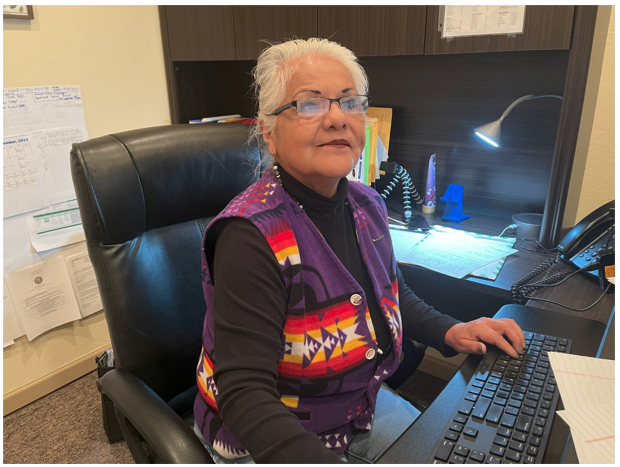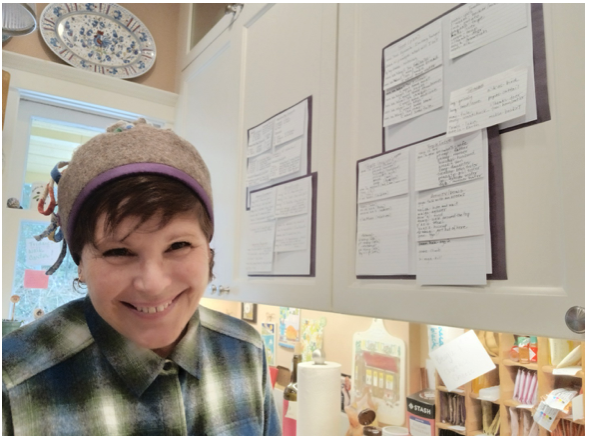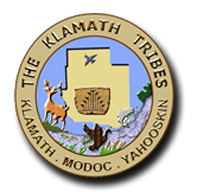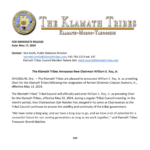FOR IMMEDIATE RELEASE
Date: June 13, 2023
Contact: Ken Smith, Public Relations Director
kenneth.smith@klamathtribes.com; 541-783-2219 ext. 147
Klamath Tribes Family Language Program Adds New Staff, Expands Curriculum
CHILOQUIN, Ore. – The Klamath Tribes has been operating a language program since the late 1980s. In May of last year, under its new director GeorGene Nelson, a family language program was launched and is now offering a more expansive and structured curriculum, with all three tribal languages being taught.
“The mission is to create fluency in Klamath, Modoc, and Northern Paiute,” said Nelson. “For our tribal membership, we’re having to develop a unique system because our language is endangered, and we have no known fluent speakers in our community right now. So, we train from the approved language books and the sounds that they have listed in there. And we focus on learning those, then we focus on making words, and we focus on making sentences.”
In 1989, the tribe created the Culture and Heritage language program, first developed by tribal member Gordon Bettles with financial assistance through a grant from the Methodist Church. The grant enabled the program to video record about a dozen tribal elder speakers. The University of Oregon produced two tribal language instructional books from those recordings. In the 1990s, Dr. Scott Delancey assisted in putting together the Klamath and Modoc language instructional book. Jana Underriner developed a language program with the tribes along with Harold Wright, Bobby David, and Mabie “Neva” Eggsman. That was also the beginning of Klamath and Modoc vocabulary being introduced to Chiloquin elementary students.
The last tribal elders known to be fluent speakers were also former instructors. The late Mr. David and Neva Eggsman, who both spoke Klamath and Modoc, and helped train tribal members Harold Wright and Stephanie Ohles in developing a training curriculum. The last known Paiute fluent speaker was the late Mr. Irwin Weiser. Weiser worked with linguist Tim Thornes of the University of Oregon to develop the Northwest Indian Language Institute (NILI) yadua language booklet for the Klamath Tribes language program. Weiser’s grandson, Steve Weiser, will begin working as a language instructor with the tribal language department beginning June 19.
A separate language program is also conducted at the Klamath Tribes Early Childhood Development Center in Chiloquin. Alice Cunial is the language teacher, and she starts teaching children as young as eight weeks old, with instruction continuing to the age of five.
During the pandemic, the Klamath Tribes Culture and Heritage Department under the instruction of Ron Busby and some of his trainees were offering language instruction through Zoom with tribal members participating throughout the United States. When Nelson was brought in to oversee the language program, she decided to continue the Zoom program because it was well-received by the participants.
“When I got here, I started to focus on what was successful with the language program,” Nelson said. “What could we do to keep going that people liked and build on that? And so, Zoom was being called for. They wanted training classes; they wanted to have them done with Zoom. And we were still at the end of COVID, so that made sense. Zoom has allowed us to have a greater reach because Klamath tribal members live outside of Klamath County. Klamath County itself is pretty large, and having to drive 30 miles to attend a class, it’s a little bit difficult, especially when you have to work all day and then drive home. So, Zoom allows us to be able to teach people fairly easily.”
The focus of the current language instruction, Nelson said, is on cultural sounds of the language, allowing students to work on enunciation of the vowels, the consonants, just as English is taught, then students study the importance of the use of vowels.
“In the Klamath tribal languages, or any tribal languages, you want to make sure that you say your vowels correctly because you could be saying a different word,” Nelson explained. “So, we work on contrast, then we work on the consonant sounds. There are 35 sounds for the Klamath tribal language and about 24 sounds for the Northern Paiute.”
Currently there are 119 tribal members enrolled in the language program, with the youngest 10 years of age and the oldest 69. Thirty-one of the students are committed to completing the entire twenty-four-week language course series. The course is broken up into three eight-week segments.
“Learning language is a lifestyle change,” Nelson stated. “One of my students said that in order to learn this language, you have to dedicate a lot of time, which creates a lifestyle change for you. And these students who come together share with me what they do, how they’re training, and how they’re learning. And some of them have got an immersion method going on where everything in their home has a sign on it in the tribal language, or they’re conversing with people in the language. Parents who have children in school, instead of reading the school books, are reading the tribal booklet with all the vocabulary words. What we’re finding is that the younger students – and this is not surprising – but the younger students are catching on a lot faster than the older students.”
The goal, Nelson said, is to have an instructor for each of the three tribal languages. There are differences in the sounds of the Modoc and Klamath languages, like the varied accents of people in different regions of England, however, the language is still understood. Paiute is a whole different language than Modoc, Nelson explained, and Klamath has its own syntax, spoken words, and enunciation.
“I would like to have an instructor who can just focus on that,” Nelson said, “because speaking from experience, sometimes you’re in one class and you’re getting ready to answer somebody, and maybe it’s Paiute that’s coming to your mind first, rather than Klamath, or if you’re in a Paiute class, it may be a Klamath coming forward, so it would just be easier for the training for somebody to focus on one language.”
As the language program expands, Nelson would like to organize classes that teach more than cultural sounds. Presently there are three levels offered: beginning, intermediate and advanced. At the beginner level, students learn the sound of vowels and diphthongs; the intermediate level focuses on words and putting sounds into words; at the advanced level, students learn grammar and sentence structure, and how to speak in phrases, as well as developing their writing skills.
The second phase of the language program will introduce tribal stories in Klamath and Modoc and offer more complex writing instructions. The ultimate goal is for students to be able to write their own stories. This is all the more challenging because historically the tribal languages were only used for oral communication.
“The tribal languages have only been written for about the last 100 years,” Nelson said. “What we use is what linguists refer to as the International Phonetic Alphabet. These symbols have certain sounds associated with them, so students also learn about International Phonetic Alphabet. They learn about the sounds those symbols make; they learn about how to use that symbol and associate it with our Klamath-Modoc sound. And we are always cognizant that your family may not say things exactly that way. So, we always ask for people to give attention to their family’s way of speaking, and that these are just basic guidelines.”
Once enrolled in the Klamath Tribes language program, you’re a lifetime member, Nelson said, with free access to the two Klamath/Modoc dictionaries of the languages, and language assistance is always available. She added that students can access the ?ewksiknii ?am hemkanks booklets or the nimi yadua booklet by going to the Language Department’s web page on the Klamath Tribes website, where the booklets can also be downloaded.
Nelson admits that her job doesn’t feel like work, and she is grateful for her position, and the opportunity to promote and develop the Klamath Tribes language for future generations.
“I love my job here,” she said glowingly. “It is so much fun to work with the youth, adults, and to see them blossom and learn how to read, write, and speak the languages. It’s the best job because it doesn’t even feel like work. By the end of the first eight weeks, students sound so good, and they have great pride when they can introduce themselves and their family in their own language.”

Klamath Tribes Family Language Program Director GeorGene Nelson in her office. (Photo by Ken Smith/Klamath Tribes. Image available for media use.)

Michelle Kirk started her Klamath Tribes language learning program and completed through to the advanced beginner course. She is now in the summer advanced group. She has been able to translate a children’s nursery rhyme into Klamath/Modoc. (Photo courtesy of Michelle Kirk. Image is available for media use.)
About The Klamath Tribes
The Klamath Tribes primary mission is to “protect, preserve and enhance the spiritual, cultural and physical values and resources of the Klamath, Modoc and Yahooskin Peoples by maintaining the customs of our ancestors.” The heart of Tribal life is centered in the area of Chiloquin, Oregon and includes 12 Departments, Health Clinic, Childcare Center, Tribal Court, goos oLgi gowa Center, Research Station, and three tribal enterprises. The Klamath Tribes’ 12 departments facilitate service delivery to multiple aspects of tribal life, including health and fitness, education, economic development, social services, cultural preservation, natural resource protection and more. For more information visit https://klamathtribes.org/.





